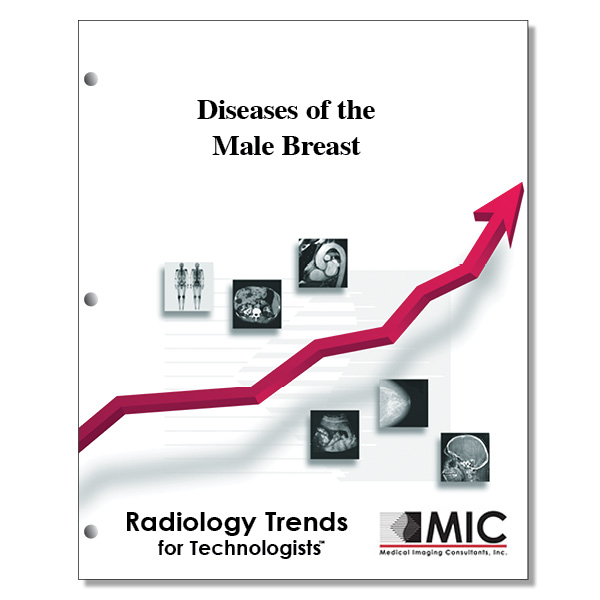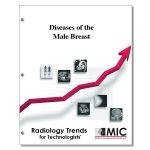

Diseases of the Male Breast
The history, clinical characteristics, and imaging features of tumors that occur in the male breast are presented.
Course ID: Q00384 Category: Radiology Trends for Technologists Modalities: Mammography, MRI, Sonography4.75 |
Satisfaction Guarantee |
$39.00
- Targeted CE
- Outline
- Objectives
Targeted CE per ARRT’s Discipline, Category, and Subcategory classification:
[Note: Discipline-specific Targeted CE credits may be less than the total Category A credits approved for this course.]
Breast Sonography: 4.75
Patient Care: 1.25
Patient Interactions and Management: 1.25
Image Production: 1.00
Evaluation and Selection of Representative Images: 1.00
Procedures: 2.50
Anatomy and Physiology: 1.25
Pathology: 1.25
Mammography: 4.75
Patient Care: 1.50
Patient Interactions and Management: 1.50
Procedures: 3.25
Anatomy, Physiology, and Pathology: 3.25
Magnetic Resonance Imaging: 3.50
Patient Care: 1.00
Patient Interactions and Management: 1.00
Procedures: 2.50
Body: 2.50
Registered Radiologist Assistant: 4.75
Procedures: 4.75
Thoracic Section: 4.75
Sonography: 3.50
Patient Care: 1.00
Patient Interactions and Management: 1.00
Procedures: 2.50
Superficial Structures and Other Sonographic Procedures: 2.50
Radiation Therapy: 4.75
Patient Care: 3.50
Patient and Medical Record Management: 3.50
Procedures: 1.25
Treatment Sites and Tumors: 1.25
Outline
- Introduction
- Clinical Background
- Normal Breast Anatomy
- Benign Conditions
- Gynecomastia
- Lipoma
- Pseudoangiomatous Stromal Hyperplasia
- Granular Cell Tumor
- Fibromatosis (Desmoid Tumor
- Myofibroblastoma
- Schwannoma
- Breast Hemangioma
- Malignant Conditions
- Invasive Ductal Carcinoma
- Papillary Carcinoma
- Invasive Lobular Carcinoma
- Adenoid Cystic Carcinoma
- Liposarcoma
- Dermatofibrosarcoma Protuberans
- Pleomorphic Hyalinizing Angiectatic Tunor
- Basal Cell Carcinoma of the Nipple
- Lymphoma and Leukemia
- Secondary Tumors (Metastases
- Summary
Objectives
Upon completion of this course, students will:
- understand the reasons men are referred for possible breast disease
- gain awareness of the most common form of male breast cancer
- discuss treatment options for male breast cancer patients
- describe the AJCC tumor staging system
- know what percent of all breast cancers are male related
- state the observable signs of a cutaneous lesion
- discuss clinical challenges in determining the extent of male breast disease
- understand which breast disease does not typically appear in males
- explain male breast anatomy
- recognize the four breast quadrants
- state the major components of the male breast
- communicate the causes of gynecomastia
- identify gynecomastia in pubescent males
- compare the 3 appearances of gynecomastia on mammography
- discuss the differential diagnosis process for gynecomastia
- describe glandular tissue associated with gynecomastia
- communicate the most common benign male breast tumor
- state the differential diagnosis for lipoma
- understand how PASH is discovered
- recognize PASH on mammograms
- understand the BI-RADS code for PASH
- communicate how PASH is demonstrated on different imaging modalities
- report from what type of cells granular cell tumors develop
- name the quadrant from which granular cell tumors most commonly appear
- express the size of granular cell tumors
- identify how fibromatosis appears on mammograms
- explain the treatment of choice for myofibroblastoma
- communicate the standard of care for diagnosing schwannoma
- know the two types of hemangiomas
- communicate adjuvant therapy options for invasive ductal carcinoma
- state the percentage of male breast cancer associated with ductal carcinoma in situ
- understand how papillary carcinoma affects men more than women
- explain the term “not otherwise specified” in relationship to male breast cancer
- understand what can cause an increase in invasive lobular carcinoma in men
- communicate the treatment for ILC in men
- be familiar with the treatment for adenoid cystic carcinoma
- know the origin of liposarcoma
- understand how to properly diagnose liposarcoma
- communicate skin layers and their relationship to dermatofibrosarcoma protuberans
- understand which imaging modalities demonstrate dermatofibrosarcoma protuberans the best
- explain the surgical excision margins for dermatofibrosarcoma protuberans
- describe how PHAT can be confused with other breast disease
- state the number of PHAT cases that have metastastasized
- discuss the metastatic potential of basal cell carcinoma of the nipple
- explain the mammographic views helpful in demonstrating calcifications in basal cell carcinoma of the nipple
- express where primary breast lymphoma begins
- understand how primary and secondary lymphoma present upon imaging
- know the classic mammographic finding associated with breast lymphoma
- state the most frequent source of breast metastasis
- list the diagnostic tools utilized in diagnosing male breast cancer
